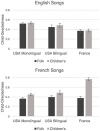Exaggeration of Language-Specific Rhythms in English and French Children's Songs
- PMID: 27445907
- PMCID: PMC4914820
- DOI: 10.3389/fpsyg.2016.00939
Exaggeration of Language-Specific Rhythms in English and French Children's Songs
Abstract
The available evidence indicates that the music of a culture reflects the speech rhythm of the prevailing language. The normalized pairwise variability index (nPVI) is a measure of durational contrast between successive events that can be applied to vowels in speech and to notes in music. Music-language parallels may have implications for the acquisition of language and music, but it is unclear whether native-language rhythms are reflected in children's songs. In general, children's songs exhibit greater rhythmic regularity than adults' songs, in line with their caregiving goals and frequent coordination with rhythmic movement. Accordingly, one might expect lower nPVI values (i.e., lower variability) for such songs regardless of culture. In addition to their caregiving goals, children's songs may serve an intuitive didactic function by modeling culturally relevant content and structure for music and language. One might therefore expect pronounced rhythmic parallels between children's songs and language of origin. To evaluate these predictions, we analyzed a corpus of 269 English and French songs from folk and children's music anthologies. As in prior work, nPVI values were significantly higher for English than for French children's songs. For folk songs (i.e., songs not for children), the difference in nPVI for English and French songs was small and in the expected direction but non-significant. We subsequently collected ratings from American and French monolingual and bilingual adults, who rated their familiarity with each song, how much they liked it, and whether or not they thought it was a children's song. Listeners gave higher familiarity and liking ratings to songs from their own culture, and they gave higher familiarity and preference ratings to children's songs than to other songs. Although higher child-directedness ratings were given to children's than to folk songs, French listeners drove this effect, and their ratings were uniquely predicted by nPVI. Together, these findings suggest that language-based rhythmic structures are evident in children's songs, and that listeners expect exaggerated language-based rhythms in children's songs. The implications of these findings for enculturation processes and for the acquisition of music and language are discussed.
Keywords: development; infancy; infant-directed modification; music; rhythm; speech.
Figures



Similar articles
-
Temporal dynamics of statistical learning in children's song contributes to phase entrainment and production of novel information in multiple cultures.Sci Rep. 2023 Oct 23;13(1):18041. doi: 10.1038/s41598-023-45493-6. Sci Rep. 2023. PMID: 37872404 Free PMC article.
-
Perceiving speech rhythm in music: listeners classify instrumental songs according to language of origin.Cognition. 2009 Jun;111(3):404-10. doi: 10.1016/j.cognition.2009.03.003. Epub 2009 Apr 8. Cognition. 2009. PMID: 19358985
-
Hierarchical amplitude modulation structures and rhythm patterns: Comparing Western musical genres, song, and nature sounds to Babytalk.PLoS One. 2022 Oct 14;17(10):e0275631. doi: 10.1371/journal.pone.0275631. eCollection 2022. PLoS One. 2022. PMID: 36240225 Free PMC article.
-
Principles of structure building in music, language and animal song.Philos Trans R Soc Lond B Biol Sci. 2015 Mar 19;370(1664):20140097. doi: 10.1098/rstb.2014.0097. Philos Trans R Soc Lond B Biol Sci. 2015. PMID: 25646520 Free PMC article. Review.
-
Lithuanian polyphonic songs sutartinės: the archaic nature of their musical language in the context of global music.Front Psychol. 2024 Feb 22;15:1285394. doi: 10.3389/fpsyg.2024.1285394. eCollection 2024. Front Psychol. 2024. PMID: 38455116 Free PMC article. Review.
Cited by
-
Perceived rhythmic regularity is greater for song than speech: examining acoustic correlates of rhythmic regularity in speech and song.Front Psychol. 2023 May 26;14:1167003. doi: 10.3389/fpsyg.2023.1167003. eCollection 2023. Front Psychol. 2023. PMID: 37303916 Free PMC article.
-
Investigation of mothers' elicited infant-directed speech and singing for preterm infants.Pediatr Res. 2025 Jun;97(7):2367-2375. doi: 10.1038/s41390-024-03618-1. Epub 2024 Oct 17. Pediatr Res. 2025. PMID: 39415040
References
-
- Abercrombie D. (1967). Elements of General Phonetics, Vol. 203 Edinburgh: Edinburgh University Press.
-
- Baruch C., Drake C. (1997). Tempo discrimination in infants. Infant Behav. Dev. 20, 573–577. 10.1016/S0163-6383(97)90049-7 - DOI
-
- Bujeaud J. (1980). Chants et Chansons Populaires des Provinces de L'ouest (Trans. Popular Chants and Songs from the Provinces of L'ouest). Marseille: Laffitte Reprints.
-
- Byrd J. (1903). Folk Songs and Other Songs for Children. Boston, MA: Radcliffe-Whitehead.
-
- Christiansen M. H., Allen J., Seidenberg M. S. (1998). Learning to segment speech using multiple cues: a connectionist model. Lang. Cogn. Process. 13, 221–268. 10.1080/016909698386528 - DOI
LinkOut - more resources
Full Text Sources
Other Literature Sources
Research Materials

